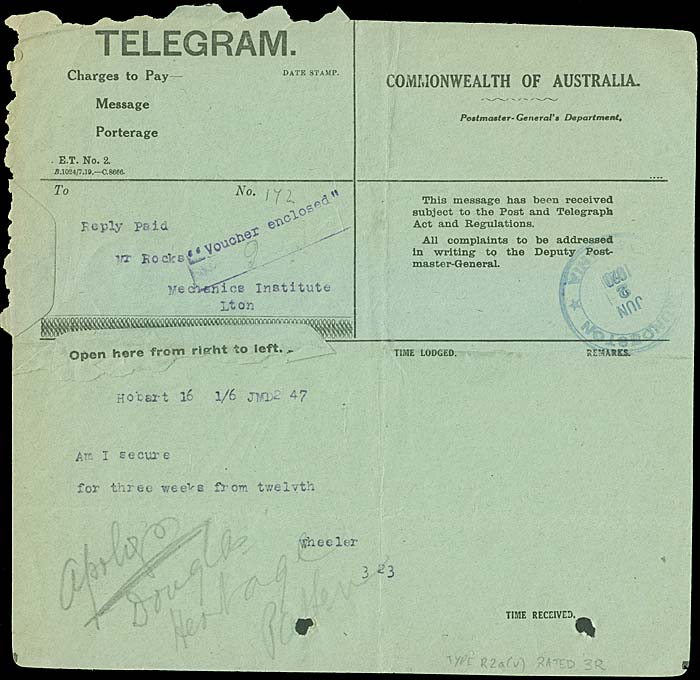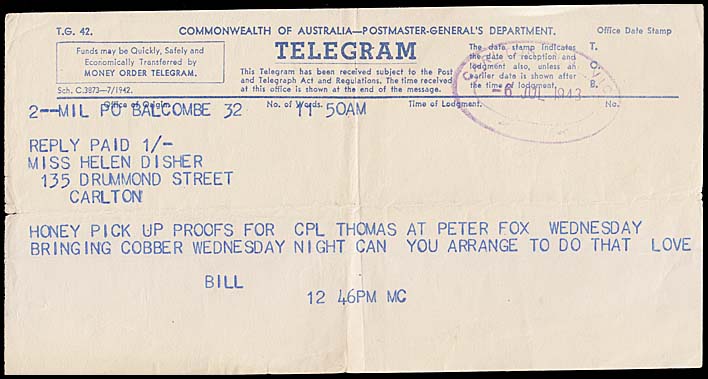Regulations for Reply paid forms and vouchers.
- Australia 1901-1988
- New South Wales
- Queensland
- South Australia
- Tasmania
- Victoria
- Western Australia
- International
- Special aspects
The Federal Post and Telegraph Act of 1901 contained the following:
Reply-Paid Telegrams — "Reply paid telegrams delivered to the public will be accompanied by a certified form enabling the receiver of same to use it to pay, or partly pay, for any telegram sent within the Commonwealth, not necessarily to be used for a reply to the original telegram received".
In 1909, the Post Office Guide elaborated on the situation as follows:
"The cost of a reply may be pre-paid and a reply form shall then be delivered to the addressee who shall be at liberty to send a telegram of the value prepaid from any telegraph office within the State. A reply-form need not necessarily be used for a reply but may be used to prepay or part pre-pay any single telegram for transmission to any place within the Commonwealth within three months from the date of issue".
The combined forms continued to be issued throughout the Interim period until February 1918 - soon after the Postmaster-General's Department finally took control of all postal and telegraphic matters. The Monthly Circular contained the following:
 Form AE-DO-1Eb printed in July 1919. Hobart to Launceston 2 June 1920. The instructions in the Post Office Monthly Circular appear to have been carried out as intended. This is a very rare example of the use of these instructions with the combined form. |
"The present combined Reply Paid form has been abolished. It has been approved to issue Reply Paid telegrams upon ordinary delivery forms, the Entry Clerk to enclose with each such telegram a duly signed and stamped "Reply Voucher" at the same time endorsing the telegram "Voucher Enclosed". Where the traffic is heavy, a rubber stamp should be provided for this purpose. In order to ensure that this voucher is not overlooked, the words "Reply Paid" should be signalled and appear on the telegram immediately before the address so that the Entry Clerk cannot fail to see them. The officer accepting a Reply Paid telegram from the sender should write the words REPLY PAID in this position (i.e. immediately before the address) and they should be transmitted by the Telegraphist. The two words so included in the address must be paid for by the sender but need not, of course, be duplicated by the sender in the text of the message" (T.B. 17-654-6).
There are no known examples of the reply paid voucher enclosed in the combined form and envelope format. |
When the combined form and envelope design (AE-DO-1) was abandoned in 1921, the previous system of a combined Reply Paid form and vouched was re-introduced with form AE-RO-1.
The 1922 Post and Telegraph regulations (p. 191) state:
339 (1) The cost of a reply may be prepaid, and a reply-form shall be delivered to the addressee, who shall be at liberty to send a telegram of the value prepaid, from any telegraph office within the Commonwealth. A reply-form need not necessarily be used for a reply, but may be used to prepay or partly prepay any single telegram or letter telegram for transmission to any place within the Commonwealth, within three months from the date of issue.
....
(5) In cases where the words “reply paid” are inserted in the original telegram, the prepaid reply shall be sent at the same rate (that is, ordinary or urgent) as the original telegram. The sender of the reply-paid telegram may, however, require that the reply be sent at either rate, by inserting the words “reply paid ordinary” or “reply paid urgent” as the case may be, in the original telegram, and pre-paying the proper charges.”
There was no special form for an Urgent Reply paid telegram - see AE-RO-2 for a rare example of an urgent reply paid telegram.
In 1928, the combined Reply Paid Form was replaced with a separate Reply Voucher - with a change in Form Number to T.G.43 in parallel to the changes for other forms. Hence when a telegram was received with the words REPLY PAID, one of these vouchers would be issued with the pre-paid amount shown as well as the Office of Origin of the initial telegram.
Instructions required that vouchers were to be stored in a safe place and only issued as necessary. They required completion in ink, the signature of the Issuing Officer and a date stamp.
 Form AW-EO-9Eb sent from a Military Telegraph Office to Carlton ( 6 July 1943). No indication of a voucher being issued but the telegram is clearly marked. The absence of a voucher probably reflects the war time restrictions. |
Vouchers for reply paid telegrams continued to be used until 1988 for Commonwealth and International prepayments.
As the form on the left shows, there were sometimes alternatives to the use of a voucher. On occasions, the rubber date stamp continued to be used but there are now few examples known (see Hancock p.246). |